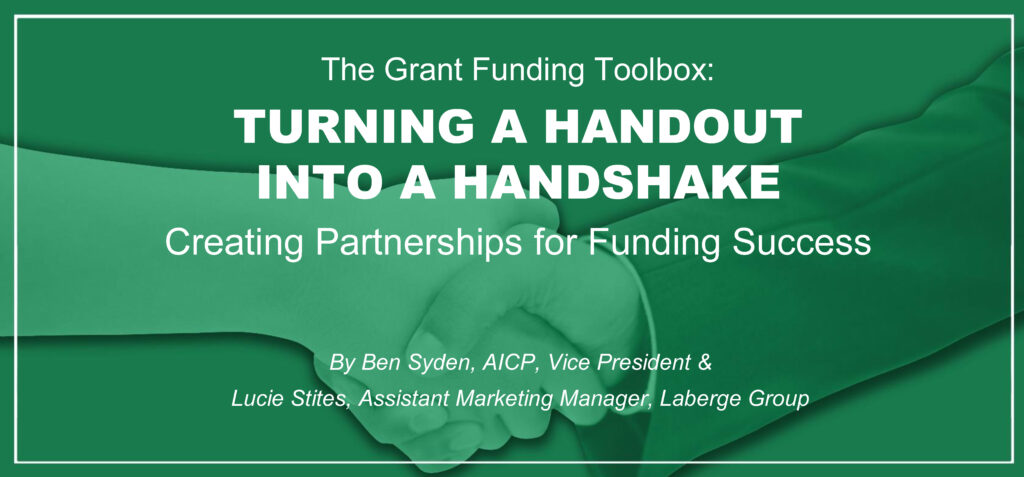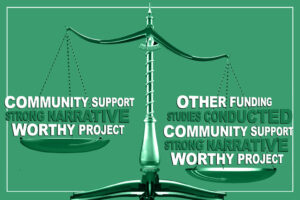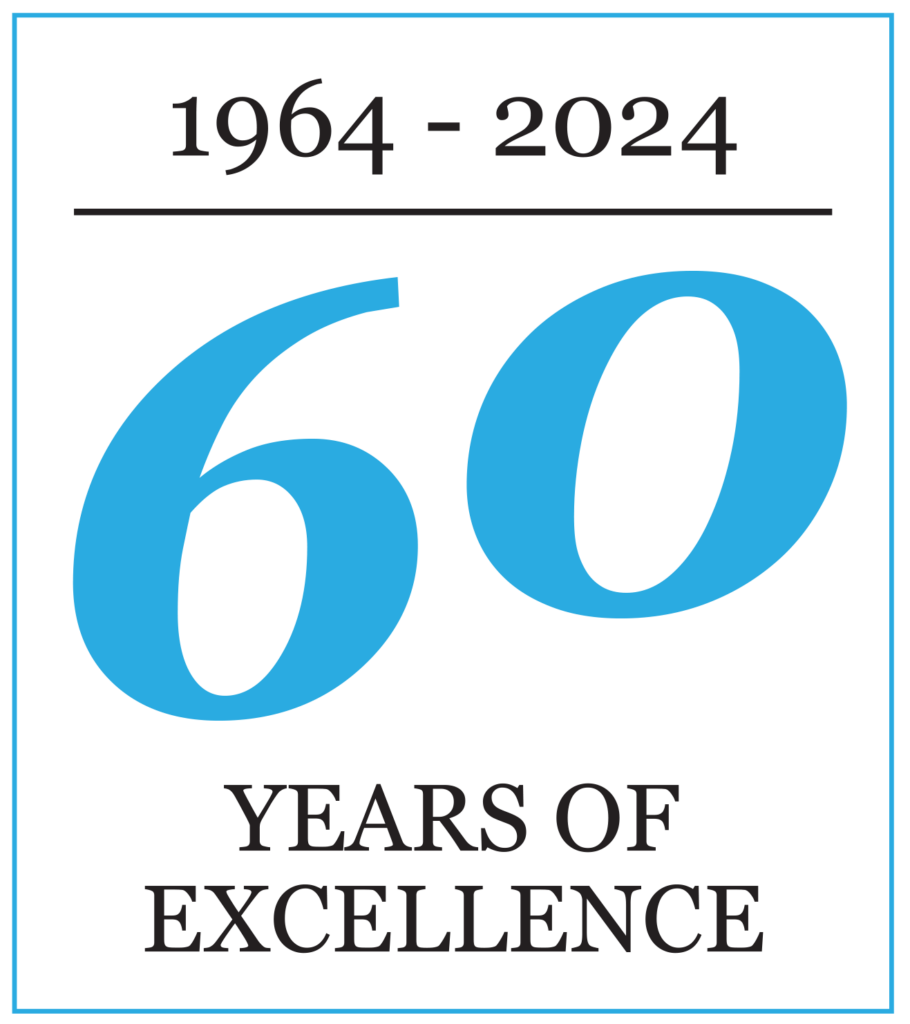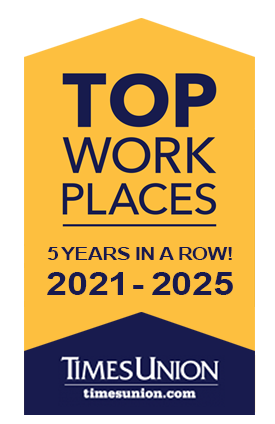
TURNING A HANDOUT INTO A HANDSHAKE = PARTNERING FOR FUNDING SUCCESS
Take this opportunity to build partnerships with grant funders rather than seeking a handout. As we stated at a recent Association of Towns grant workshop, now is the time to turn a HANDOUT into a HANDSHAKE.
How is that accomplished? The fundamental framework that turns a handout into a handshake is partnership – working together toward a common goal. Partnering with a funding agency entails the 4 TOOLS detailed below to help the funding agency achieve THEIR mission by INVESTING in yours.
1. Perspective is the Key
The first step is to convert your mindset from that of a grant-seeker, to a partner in progress. When you carefully consider the point of view of the funding agency you’ll be submitting an application to, it will allow you to consider how to solve their problems in order to address your own. It’s not manipulative, it’s partnership.
Remember that each funding agency has a mission to accomplish, whether that be to stimulate economic growth in low-income communities or to support infrastructure initiatives to ensure clean and safe drinking water. In order to set up for a true partnership, it is important to work along parallel tracks with your funding partner. Track 1: Project initiation- determining the needs and potential solutions for your community; and Track 2: Identification of potential funding sources and agency priorities. This dual-focus during project launch will help ensure that the project is crafted to meet BOTH the funding agency’s mission and your community’s needs from the outset – laying the groundwork for a true partnership toward a common goal and providing an opportunity for the agency to invest in an initiative that will further their mission.
 Note that this is the opposite of skillfully describing or cunningly re-wording a project description to fit an application after the fact. This is much more than filling in a box, or twisting a program to meet your needs, it is forging a relationship that is mutually beneficial. You are helping the agency invest in high quality projects, while simultaneously implementing your local project. Remember, your perspective changes based on what side of the table you are sitting on.
Note that this is the opposite of skillfully describing or cunningly re-wording a project description to fit an application after the fact. This is much more than filling in a box, or twisting a program to meet your needs, it is forging a relationship that is mutually beneficial. You are helping the agency invest in high quality projects, while simultaneously implementing your local project. Remember, your perspective changes based on what side of the table you are sitting on.
2. Answer the Most Challenging Questions
The most fundamental questions that communities must answer for grant funding agencies aren’t explicitly written in the grant applications. In a highly competitive round of funding, why should we invest in you? Why is your project the best use of our funds to help accomplish our goal? And why are you the best partner to work with toward achieving that goal? Using the partnership framework, when the time comes to develop the grant or financing application, you will be prepared to answer these questions, framing your project as a worthy investment opportunity to advance the mission of the funding agency.
3. Keep the Lines of Communication Open
In order to fully understand what type of projects the agency is looking to fund, open communications are essential. Speaking with funding officers is the best way to gain a nuanced understanding of the funding entity’s specific priorities. For instance, often grant funding agencies adjust their metrics for reviewing grant applications based on local or federal regulations or programmatic changes. While the funding officers will gladly discuss these new metrics with you if asked, often important information cannot be easily found in the grant application directions. Without initiating a direct dialogue with funding agencies, you may miss out on meeting one of their top annual priorities or miss securing crucial points in the review process.
If you don’t feel comfortable working directly with funders, find an experienced consultant with a strong history of grant success with the funding programs. Armed with these insights, you can be a true partner in providing the funding officers with optimal investment opportunities to meet their objectives.
4. Meet Critical (and Unwritten) Metrics
Not only does each agency as a whole have a mandate to carry out, the funding officers who will be reviewing your community’s application have specific metrics they’re required to meet. Picture a funding officer reviewing a mountain of grant applications. What is your initial reaction to that mental image? Do you see her or him as a gate- keeper? A hurdle to overcome? A customer to sell to? If so, it’s time to shift your perspective. If you’re able to put yourself in the funding officer’s chair and see things from his or her point of view, it will benefit both parties.
Just as funding agencies are project partners rather than neighborhood banks, their officers are investment professionals, not gate-keepers or drive-thru tellers. They’re charged with carefully selecting the most promising investments according to specific criteria and metrics for success that are more stringent now than ever before. To partner with those officers is to make them successful in achieving their missions.
As such, you must help them meet those metrics. So what are some of the mandates and metrics that most funding officers have in common that you can help them meet?
METRIC 1: Putting Money to Work Right Away
While it has long been an industry buzzword, “shovel-ready” is now practically a household word. Eager to jumpstart the economy, it’s not surprising that funding entities at the State and Federal level are prioritizing projects that can be put into action right away to impact the economy as quickly as possible – and funding officers are charged with determining which projects most successfully meet this metric. What constitutes project readiness? That varies depending on the project, of course, but in the case of infrastructure initiatives, it generally means that most, if not all, of these items are completed and ready to go out to bid:
- Studies, assessments, and reports that demonstrate project need and
an implementable path forward; - Complete financing plan with all funding committed (except the grant that you are applying for);
- Site control;
- Preliminary and final designs;
- Evidence of fiscal viability (including third-party validated budgets);
- Environmental studies;
- SEQRA documentation;
- Surveys and basemapping; and
- Documentation of community support and key partnerships.
If presented with several projects of equal significance and impact, one of which has environmental studies completed and SEQRA documentation submitted so that it is cleared to proceed, while the others do not, it is more likely than ever that the shovel-ready project will receive the funding. No matter how compelling the narratives or public support statements of the other applications may be, it is unlikely that they will prevail over a project that can put the funding entity’s money to good use immediately.
 METRIC 2: Leveraging Funding from Multiple Sources
METRIC 2: Leveraging Funding from Multiple Sources
With available funding at critically low levels, and the need to stretch the dwindling funds across more communities than ever before, funding entities have to ensure that each dollar they commit leverages other investments – i.e. local community funds, private investments, or funding provided by another agency. Similar to their counterparts in the private sector, funding officers (“investors”) are facing increasing pressure to identify investment opportunities in which theirs is the “last money in,” helping a project that is already making great strides, cross the finish line. So what are the prime opportunities to line up other investments to leverage in helping funding agencies meet this mandate?
Community Funds: Like private equity firms, public funding agencies are looking for project leaders who have “skin in the game.” Even in times of significant economic cut-backs, it may be possible to isolate a specific project component that can be funded by the community. Work with the Board and relevant department heads to find a project component that will generate strongest impact from the smallest investment.
Private Funds: Public Private Partnerships (PPPs) utilize private sector funding to assist the public sector. These private investments are typically geared toward stimulating economic development and job creation, but partnerships that stimulate economic growth can span a wide range of projects from downtown revitalization planning to infrastructure improvements that attract and support future development.
Investments from other State and Federal Agencies: New and more stringent metrics have been established by some funding agencies. One recent metric added by a popular funding sources is a requirement that applicants apply for all other available grants and financing avenues prior to submitting an application to this agency. The new approach will identify the critical need for agency funding and increase its return on investment by providing the final funding component, or last piece of the fiscal puzzle. Grant toolbox tip: Often agencies don’t explicitly stipulate significant new metrics in their application instructions. Applicants should take the time to reach out to prospective funders to determine if they have introduced new metrics, and if so, how important they may be in the evaluation of your application.
METRIC 3: Expanding the Partnership
The problem that you’re facing may also be an issue for your neighboring community. While the concept of finding and funding a “shared solution to a joint problem” is not new to community leaders, shared services, consolidation, and/or functional consolidation are a natural way to expand the partnership, and may be more important than ever in these days of fiscal challenge. Creating an inter-municipal agreement and applying for a grant jointly with another community achieves three things: it adds a potential municipal funder into local match funds, it extends the reach of the State agency into multiple jurisdictions, and it may potentially be a more efficient deployment of government services (with quantifiable savings that can be shown in a joint budget).
 Tilting the Scales in your Favor
Tilting the Scales in your Favor
If a funder is forced to choose, as they often are, between equally worthy and impactful projects submitted by several communities, how are they to determine which to fund? If you’ve read this far, you know it’s not a coin flip. Communities that demonstrate shovel-readiness and commitments from other funding sources that can leverage a funding agency’s investment and stretch their limited funds will have a decided advantage.
The Time is Now
When is the best time to begin preparing to build this funding partnership? The rule of thumb on this may surprise you – approximately one year out. With many municipalities drafting budgets in the early fall, being able to commit funds in advance of the grant season is a strategic step in showing project commitment.
With many applications due in the summer, this is the perfect season to build or revisit your project and funding plan, schedule discussions to help prioritize projects, and begin strategizing how to build your project-specific funding partnerships for the following year.
Published in the July/August issue of the New York Association of Towns’ publication, “Talk of the Towns.”
Laberge Group employs a unique approach to project and grant development in which grant writers and engineers work collaboratively to design projects that meet the needs of both our client communities and the funding entities whose investments take projects from conception to implementation. This approach has resulted in securing $275 million in project funding since 2000.
If your community is in need of grant funding to implement a project, please fill in this short form and we’ll be in touch right away. A short conversation today could mean a world of difference for your community for years, decades, or even generations to come.


